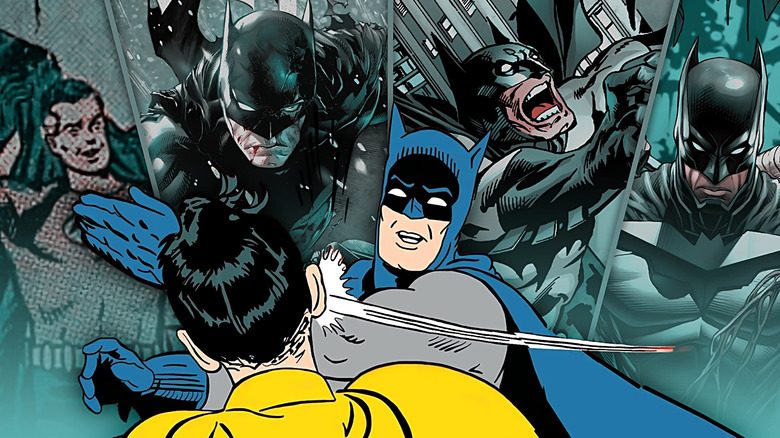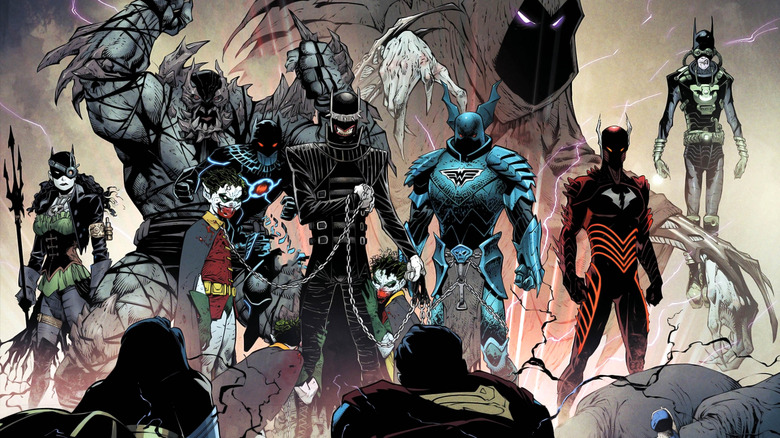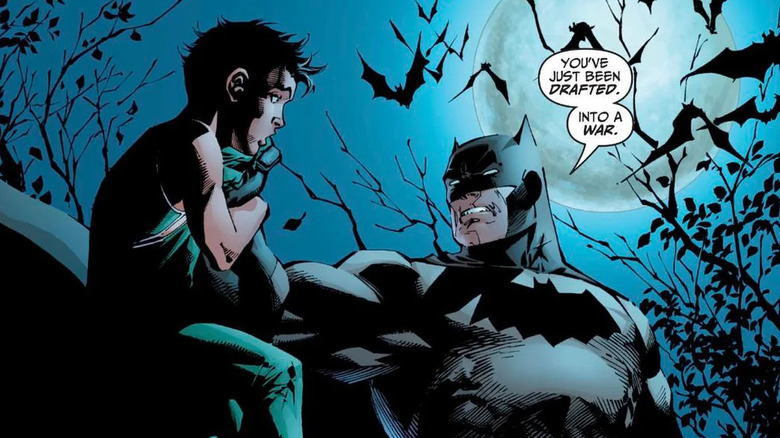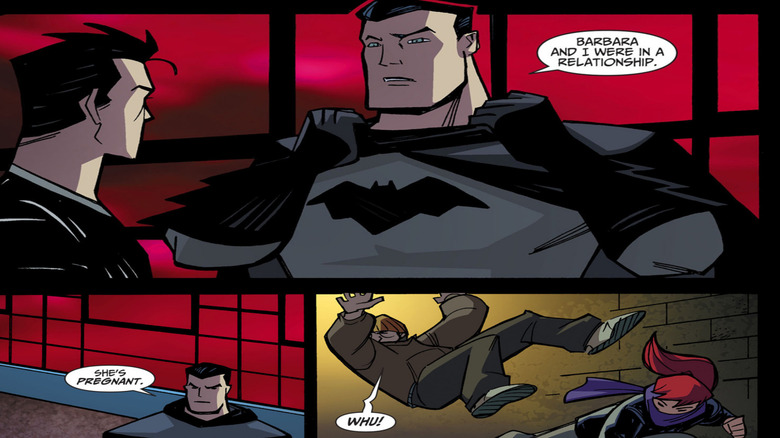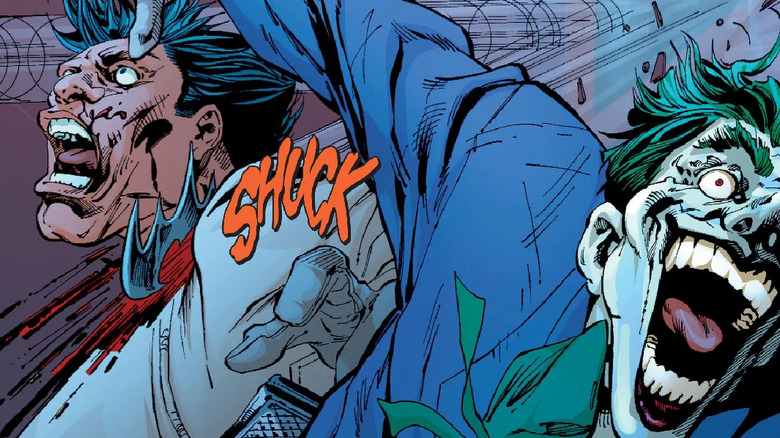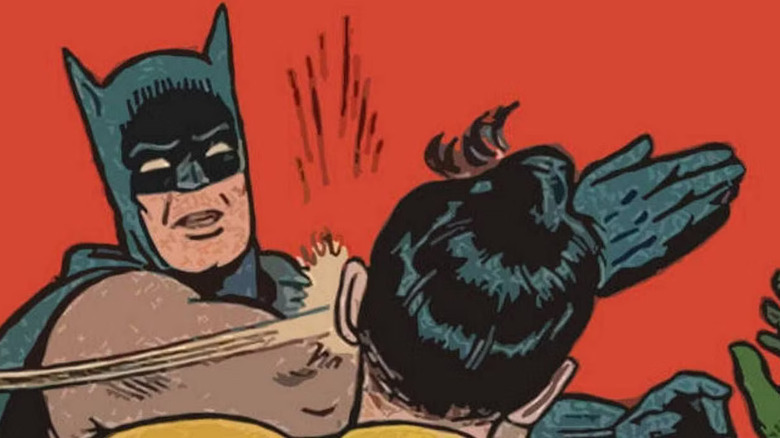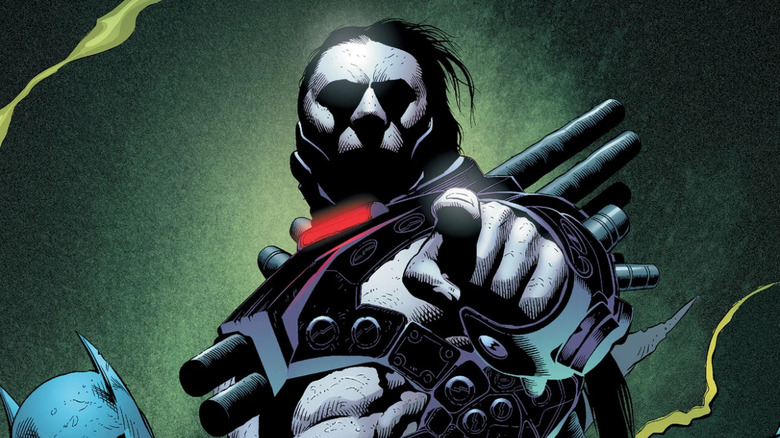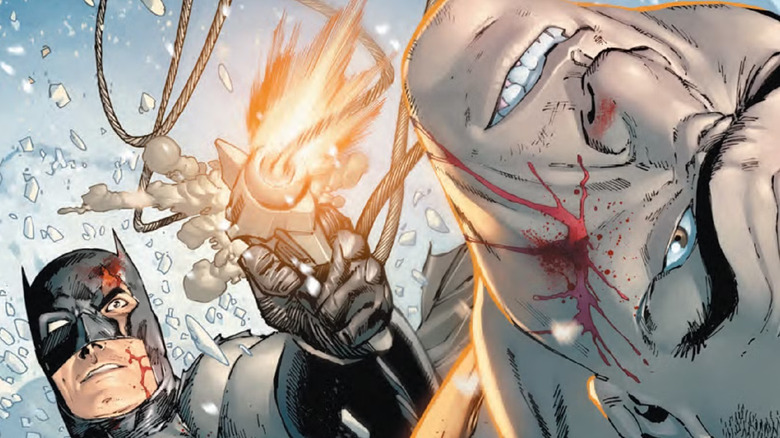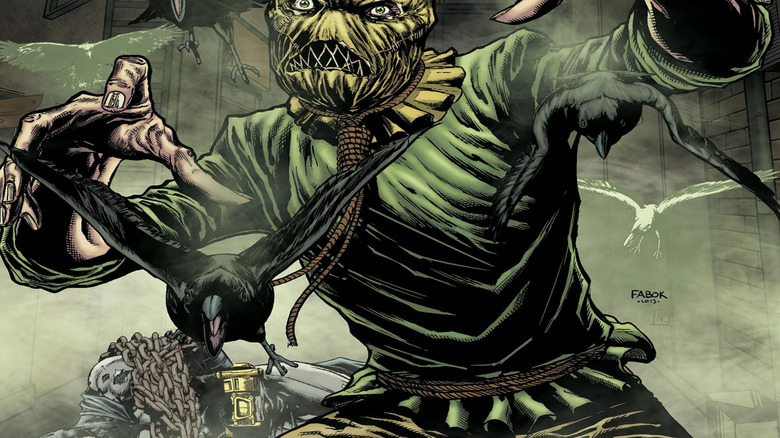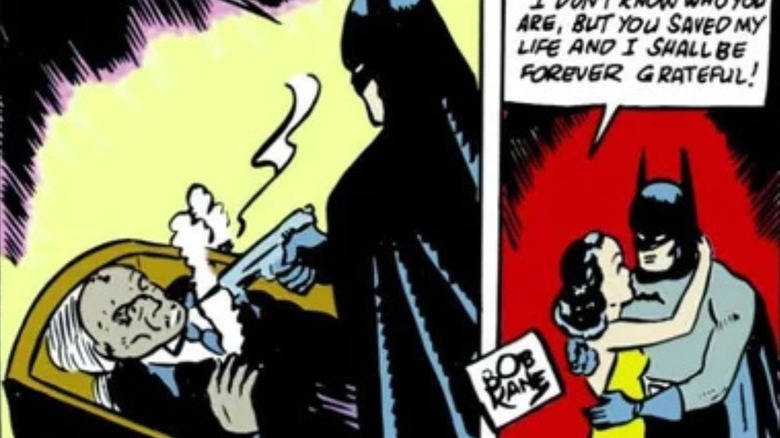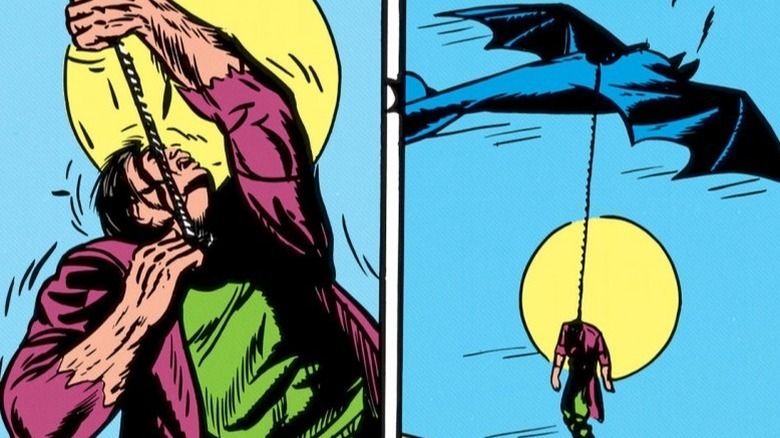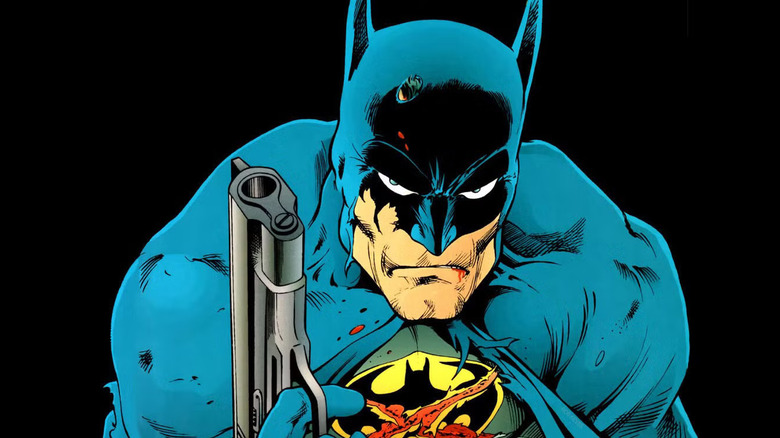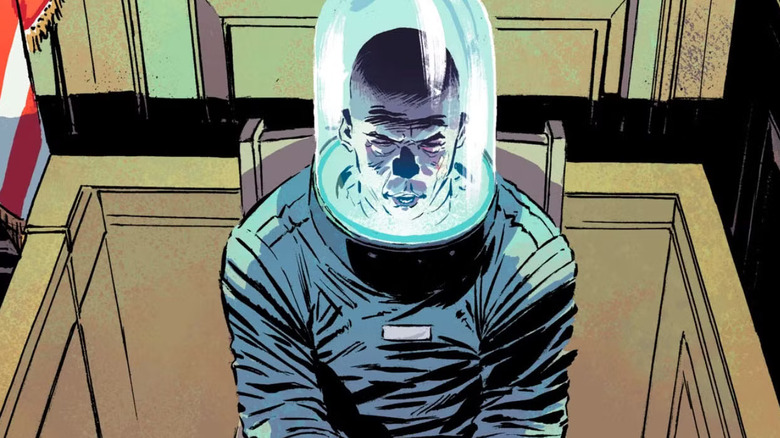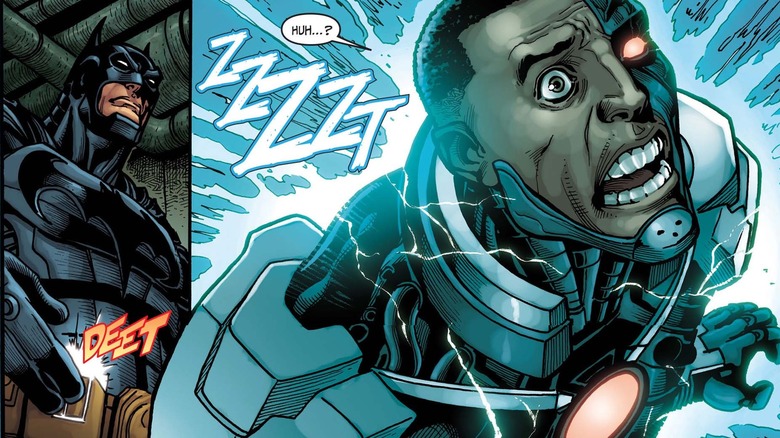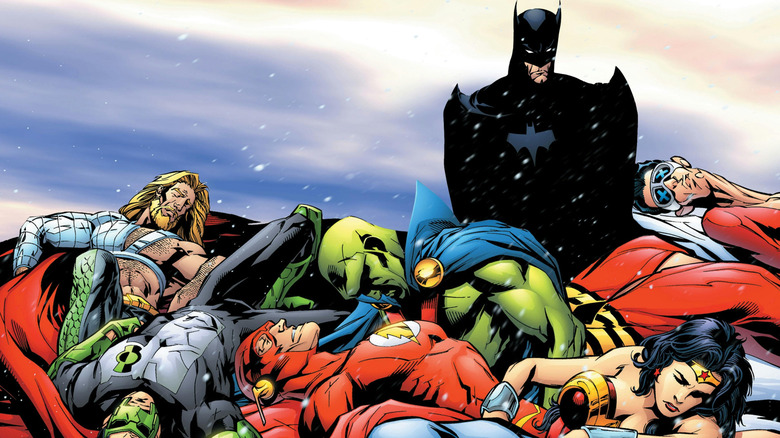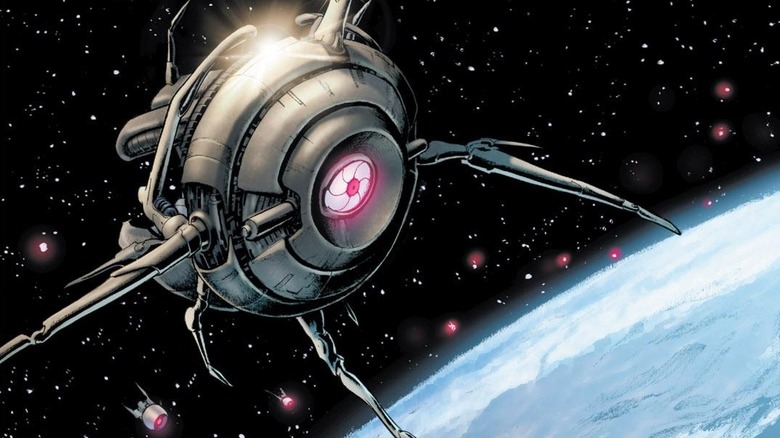The 15 Worst Things Batman Has Ever Done
As one of the greatest superheroes ever created, Batman has a special place in the DC Comics canon. Though he's been rebooted, remixed, and reinvented more times than we can count (most recently in Matt Reeves' "The Batman" film and Scott Snyder's Absolute Universe in the comics), he's almost always characterized as a tragic romantic hero who uses his incredible wealth to save a city ravaged by crime and institutional decay. This one-man war on crime, waged without powers, has earned him the respect — and, more importantly, fear — of the DC Universe's heroes and villains.
But Batman has made decisions over the decades that are far from respectable. With a desperation to prevent the loss of innocent life, an unparalleled superiority complex, and a pathological distrust of his closest allies, he poses a danger to the world that rivals the most dangerous criminal masterminds.
The Dark Knights
For the most part, we'd like to keep this list focused on the worst things the more mainstream versions of Batman have done. It is also crucial, however, to examine certain variants that — while perhaps not accurate to how most — if any — fans see the character — explore the possible logical extents of the various, deeply anti-social values held by the mainstream versions of the character who fans do identify as the "real" Batman. There are no variants more useful for this purpose than those found in the dark multiverse, a set of apocalyptic or near-apocalyptic alternate Earths born entirely of fear.
On an Earth terrorized by an evil, out-of-control Superman (*heavy sigh for comics' most tired trope*), Batman effectively turns himself into Doomsday to stop him; on another, he develops an evil paternal A.I. after Alfred dies, continuing his pathological avoidance of natural grief. Fully believing in the moral superiority of his vigilantism, one variant of Batman steals the power of Ares, the Greek God of War, only to be instantly overwhelmed and corrupted by it. In these worlds and others in the dark multiverse, versions of Bruce Wayne do horrific things not despite his ideology, but because they use it to react to tragic or complicated circumstances that reveal its limits.
Turned orphans into vigilants
As for the most mainstream version of Batman, three major complaints get thrown his way, usually by casual (non-derogatory) fans interrogating the unavoidably dubious characterization of a character who, shockingly, could not, would not, and in fact does not exist in the real world. The first and most popular is that Bruce Wayne is a billionaire (derogatory) who should simply use his riches to save Gotham City, rather than his fists — which, side-stepping a broader (and contextually useless) conversation about what charity could actually solve, can and should be dismissed by the mere nature of most "Batman" comics as action-adventure stories. The second criticism is less easy to ignore.
This is, of course, that all of Batman's sidekicks are young children and teenagers who (though having experienced very different lives before joining his crusade) universally look up to him, to the point that most of them have seen him as the patriarch of their Bat-Family. This is especially true for the first three Robins — Dick Grayson, Jason Todd, and Tim Drake — all of whom were adopted by Bruce Wayne. Fans are quick to point to meta-explanations like the fact that the comics need and benefit from heroes who are relatable to young people, as well as in-universe justifications like the children's shared affinity for crime fighting prior to joining Batman. Even so, throwing these kids onto the front lines of a lifelong war just feels unbelievably wrong.
Impregnated his adopted son's girlfriend
Unfortunately, in some continuities, turning his wards into sidekicks is far from the most disturbing thing Batman has done to the youths who trust him. Barbara Gordon — the daughter of longtime Batman's friend and collaborator Jim Gordon, who works with the Dark Knight herself as Batgirl — is often written as being seriously romantically involved with Batman's adopted son Dick Grayson. In the future-set DC Animated Universe TV series "Batman Beyond," however, an older Barbara says that after she dated Dick, she and Bruce started a romantic relationship.
It gets even ickier when it is revealed that Barbara and Bruce had an affair behind Dick's back while they were dating, and that it resulted in Barbara becoming pregnant with Bruce's child. Though Bruce was initially going to let Barbara handle the situation on her own, he ultimately steps in and tells Dick personally because he's afraid Dick is thinking about proposing to her and is trying to deter him. The levels of messed-up here are too many to tally, but that Bruce would get involved in this way with two people he mentored is hard to stomach.
Chose the Joker's life over Jason's
Despite what he did to Dick and Barbara, the sidekick Batman undoubtedly failed the most is the second Robin, Jason Todd. In the storyline "A Death in the Family," Jason is killed by the Joker while trying to help Batman stop an Iranian terror plot — that storyline is way weirder than we remember. When he is eventually revived in the Lazarus Pits by Talia al Ghul, Jason holds Batman personally responsible for his death, not for signing him up to be a vigilante, but for refusing to kill criminals like the Joker. But Jason's death is not the focus of this entry.
Regardless of whether or not you agree with Jason, Batman actually does choose the Joker's life over his in the final showdown between the three of them in the original Red Hood storyline. At the climax, Jason asks Batman to kill the Joker to save them both. Instead, Batman slits Jason's throat with a Batarang, lets the building get blown up, then leaves Jason to die in the smoldering rubble — after he rescues the Joker. The ending is revised significantly in the far superior film adaptation.
Smacked Robin senseless
Chances are, you've already seen the panel from "World's Finest" Issue #153, in which Batman smacks the lights out of Robin. But while this meme has gone viral online and been a mainstay of awful Facebook posts for over a decade at this point, few who share the panel likely know the story behind it.
In the issue, Batman becomes convinced that Superman murdered his parents when he was a young vigilante going by the name Superboy. Robin (Dick Grayson) is understandably distressed to hear this news, and tries to get Batman to explain himself. But when Robin tells Batman outright that he must be wrong, Batman smacks him, fires him as Robin, and disowns him as his son. He even uses a machine he stole from a supervillain to brainwash Dick so that he forgets everything he knows about Batman, Bruce Wayne, and his time as a vigilante. Dick is then sent to an orphanage so that Bruce can dedicate all of his time and effort to taking down Superman.
Permanently wounded low-level villains
The third and final common criticism leveled at Batman is that, in his capacity as an extra-judicial crime fighter, he spends the majority of his time beating unwell criminals to an absolute pulp. Though many will immediately dismiss this criticism by pointing out that Batman is almost always saving lives in the process, this doesn't entirely make up for the extremity of his methods — or the lives those methods ruin.
The comics confronted this critique in the New 52 with a villain called Terminus. Because of an encounter with Batman, Terminus lives with a condition that leaves him in a constant state of physical decay. Unable to find a cure, he rounds up a number of villains — all of whom have also been maimed, permanently disfigured, or disabled by Batman — to execute a final act of vengeance meant to tarnish the hero's legacy. He ultimately fails, and there seems to be little — if any — introspection on the part of the Bat-Family about the way they treat criminals.
Essentially killed KGBeast
One could argue that most of the street-level, low-rent villains that Terminus recruited got off easy, considering what Batman has done to his more significant foes. During the Rebirth era of "Batman" comics, when Dick Grayson is nearly assassinated by the Russian supervillain KGBeast, Batman tracks him down to the secluded home of the villain's father. The two of them have a knock-down, drag-out fistfight that ends with Batman firing his grappling hook into the Beast's chin from point-blank range.
The sheer force of the projectile breaks his neck. When KGBeast asks Batman to get him help, however, Batman coldly refuses and leaves him to die in the snow. This isn't even the first time Batman has essentially killed this character, as the first KGBeast storyline back in the late '80s ended with Batman trapping him underground with no food, water, or hope of escape. Batman also nearly killed him in Scott Snyder's "All-Star Batman" continuity, and basically set him on fire in Zack Snyder's "Batman v Superman: Dawn of Justice."
Drove Jonathan Crane insane ... or, more insane
Speaking of Batman villains who routinely get the same harsh treatment, there's an argument to be made in multiple continuities that the Caped Crusader himself is responsible for the insanity of Dr. Jonathan Crane. The supervillain better known as the Scarecrow uses variations of his dangerous fear toxin to force his victims into hallucinating that their worst fears have come to life. While this toxin has seriously harmful psychological effects, it also frequently causes direct physical harm, like cardiac arrest.
Despite this, it's almost a trope at this point that Batman will force a dose of this toxin on Scarecrow as a means of defeating him. In Christopher Nolan's "Batman Begins" (which has an infamously loose understanding of Batman's code of ethics) and the video game "Arkham Knight," the life-threatening nature of the gas is particularly emphasized. Yet, in both projects, Batman forcefully gasses Scarecrow (despite arguably having him subdued both times). "Begins" is especially fascinating because when we see Crane in later films, he appears to be more unwell as a consequence of the toxin.
Shot a man in his sleep
With this list, we specifically tried not to simply rehash all the times the Golden Age iteration of Batman straight-up murdered someone for committing a crime. He's thrown multiple people off of rooftops, kicked a guy's throat into a knife, and even dropped someone in a vat of molten metal. All of this is non-canonical now, but there are two moments that still stand out to us as particularly disturbing.
The first comes from a 1939 issue of "Detective Comics," in which Batman is stalking his vampiric nemesis known as The Monk. He kidnaps Bruce's fiancée and hypnotizes her into abandoning the billionaire and vacationing with him in his Hungarian gothic castle, at which point Batman decides he's had enough, packs up his trusty pistol, and follows them. When he arrives at the castle, there's no brawl or dramatic confrontation — while his enemy is sleeping in a coffin, the Dark Knight simply walks up and executes him in his slumber with a single shot to the head. Golden Age Batman was ... something else.
Personally hanged a man from the Batplane
The second example comes from the very first issue of "Batman" from 1940. The issue sees Batman come up against Dr. Hugo Strange, a criminal mastermind who remains a prominent antagonistic force in "Batman" stories to this day.
Though Strange himself is no match for Batman, he has employed the help of some superpower henchmen who are impervious to the hero's usual arsenal — which, at the time, included a military-grade machine gun strapped to the undercarriage of the Batplane. When one particularly rough customer proves to be bulletproof, Batman sends a rope down from his aircraft, lassos it around the man's neck, and drags him into the air. The man stops moving after a panel of struggle, presumably killing him. With this lifeless body dangling from his plane, Batman blithely remarks, "He's probably better off this way." Sheesh.
Planned to end his crime fighting career with a double homicide
In the 1987 prequel storyline "Batman: Year Two," DC Comics ventured back to the (retconned) beginning of Batman's career — where, much like the actual beginning of Batman's career we just discussed, he was very much into guns. No, he wasn't shooting monks or machine-gunning metahumans, but he was ready to go out with a bang.
Having met the saint-like love of his life, Rachel Caspian (a woman so pure of heart she's one bad day away from joining a convent), Bruce is ready to retire and settle down. The only problem is he currently happens to be getting his cape kicked in by the original Gotham vigilante, the Reaper, who has a much more Golden-Age-Batman approach to dealing with criminals. To secure a future with his wife before she gets impatient and takes her vows, Batman has a truly incredible plan: He'll simply help Joe Chill, the man who murdered his parents and sent him on this descent into crime fighting nightmare, kill the Reaper — after which he himself will kill Joe Chill and retire.
A real making-sense type of plan for sure, but there's one problem: The world's greatest detective didn't realize that, underneath the mask, the Reaper was Judson Caspian, Rachel's father, who became the Reaper after Rachel's mother was murdered. In other words, Batman was trying to help the man who turned him into an orphan turn the love of his life into an orphan as well. In spite of Judson killing Chill, he dies during his final fight with Batman — and in spite of Bruce coming to his senses and swearing off guns, Rachel still leaves him to join the nuns.
Scared Mr. Freeze into confessing to crimes he didn't commit
Thanks to one of the best episodes of "Batman: The Animated Series," Mr. Freeze is regarded as a uniquely sympathetic Batman rogue. It was all the more awkward then when Batman almost wrongfully sent him to prison for murder.
After Selina Kyle left him at the altar during Tom King's run on "Batman" in the Rebirth era, Bruce was so angry that he mistakenly came to the conclusion that Freeze was responsible for murdering multiple women, and was so ruthless in his pursuit that Freeze confessed out of fear for his life. In fairness, the concept of marriage seems to put Batman in a real killy mood.
Before you get mad or start throwing out wild accusations like, "This is what happens when a billionaire appoints himself the violent sheriff of Murderville," don't worry. He made everything okay by bribing a bureaucrat so he could score a seat on Freeze's jury. (It's actually a pretty great story about grief and accountability, and it's in "Batman" #51-53 — you should check it out.)
Violated Cyborg's hardware as a teenager
The continuity of the "Injustice" video games is nearly identical to that of the mainstream DC Universe — up until the point when a nuclear attack by the Joker turns Superman into a homicidal dictator. Long before this version of Cyborg joined the Man of Steel's fascist initiative, he was presumably still a recent high school football star whose whole world was irreversibly changed by life-saving cybernetic upgrades.
Though this came with many drawbacks, it did give him the chance to become a member of the Teen Titans — and, subsequently, the chance to meet the one and only Batman. But as we learn in the "Injustice" comic book series, while teenage Vic Stone was meeting one of the world's finest, Batman was figuring out a way to infect his cybernetics with debilitating malware. As disturbing as this is, it's an example of Batman's near-sociopathic level of paranoia.
Developed contingency plans for the Justice League
As seen in the comic book storyline "Justice League: Tower of Babel," its loose animated film adaptation "Justice League: Doom," and various alternate timelines, Batman is infamous for developing so-called "contingency plans" for his fellow Justice League members. These plans are basically collected devices and strategies to neutralize the heroes with varying levels of lethality, should they ever go rogue. The obvious hypocrisy usually at play is that Batman has appointed himself as moral arbiter of the Justice League, often without a tangible contingency for his own potential downfall.
Giving credit where it's due, Batman's contingency plans have saved lives in the past. In "Batman: Endgame," his "Justice Buster" suit is able to subdue the Leaguers (without the usual inhuman psychological and physical maiming) when they're brainwashed by the Joker. When the evil Justice League of Earth-3 invaded in "Forever Evil," they were also able to provide resistance against the all-powerful threat. Even so, their mere existence doesn't make Batman look great — especially when you consider the plans' origins.
Spied on superheroes using Brother Eye
In the Pre-New 52 DC Comics continuity (in which "Tower of Babel" takes place), the contingency plans are just part of Batman's magnum opus of paranoia — Brother Eye. A satellite he secretly built and launched into space, it was able to covertly feed the Dark Knight intimate information about his closest allies for years, as well as store data on their personal histories and potential weaknesses.
In "Tower of Babel," this system is hacked by Ra's al Ghul, allowing him to nearly take down the League. It was also hacked by Maxwell Lord (in a plot to massacre superhumans and slaughter the Amazons of Themyscira) and the Lex Luthor of Earth-3. Even if it weren't so easily compromised, Brother Eye is proof that Batman's fractured psyche, though masked by a ruggedly individualistic mission, makes him just as — if not more — dangerous than his enemies.
